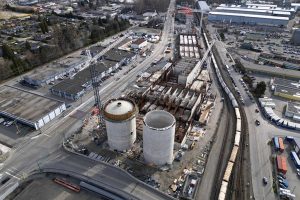Demolition, expected to to be complete by March 2012, is underway at the Rio Tinto Alcan Kitimat smelter rebuild.At the same time, 250 contractors have gone through a Vancouver briefing preparing for the next phases of the $2.5 billion build out.
Demolition, expected to to be complete by March 2012, is underway at the Rio Tinto Alcan Kitimat smelter rebuild.
At the same time, 250 contractors have gone through a Vancouver briefing preparing for the next phases of the $2.5 billion build out.
The recent Vancouver briefing outlined the project, how contractors qualify and allowed major Canadian construction firms to meet local contractors already engaged on site since 2008.
“We have maximized the use of local contractors,” said Rio Tinto Alcan project director Michel Lamarre, as major and local contractors met and mingled in a tradeshow atmosphere.
“There was a lot of exchanging of business cards and hopefully they will work together,” he said.
The Kitimat Modernization Project first phase demolition involves freeing up real estate to shoehorn in the new structure in the old smelter, while it continues operations. Lamarre said the new smelter would have a capacity of 420,000 tons compared to the existing facility’s 200,000 tons.
“It is a state of the art facility, which is very efficient and has a smaller footprint,” he said.
A 60 per cent footprint reduction will be achieved during the multi-phased rebuild stretching over 30 months to finish in 2014.
The remainder of the plant will then be shutdown.
Smelting potlines Nos. 7 and 8 are being gutted, which followed a clean-up operation to mitigate contamination from rainwater leaching, as the structure encapsulating the lines is dismantled.
A partnership between Quantum Murray (in Vancouver) and Northwest Demolition Canada ULC, a subsidiary of Oregon-based Northwest Demolition is doing the work.
“We are doing the cleaning, the hazardous abatement and waste management,” said Steve Custeau, vice-president of Quantum Murray.
He said the challenge facing the crews on site is a tight time line for work.
Bechtel’s Andy Lederman, director of Engineering, Procurement and Construction Management, said Hazco Environmental Services Ltd. has the contract to supply technical support to ensure stringent water and soil requirements are met.
Northwest Demolition Canada is removing the structure.
Vice president Richard Wayper said the rigging and removal has been subcontracted to Envirocon.
At the peak of the demolition work, an estimated 340 workers from the Quantum/Northwest partnership will be on site.
Bechtel’s Mike Grealy, KMP engineering and construction project manager, is also the contracts manager.
Those contractors wanting to get on bid lists or receive expression of interest cards can contact him at Rio Tinto Alcan’s Montreal office. Suppliers wanting to get on bid lists should contact Al Stewart, also in the Montreal office.
Lamarre said the plunge in metal prices in 2008, when the project was initiated, was a silver lining, as it allowed smaller contracts to proceed with local contractors who have now learned Bechtel’s safety and work culture.
As well, it allowed Rio Tinto Alcan to refine its plan to gain better efficiencies. It spent $300 million in prep work in 2010 and another $300 million is budgeted for 2011.
Local contractors are also helping with the relocation facilities on site caused by the disruption of initial construction, the construction of a utility corridor and storage shed.
Contractor IDL Projects of Prince George received the contract in early June for the underground utility corridor carrying natural gas, industrial water and potable water pipes, as well as high voltage and fibre-optic cables in a three-kilometre loop around the new smelter.
Construction started in late June. Lamarre said having the underground utility corridor in place would expedite construction.
IDL is working with the building trades to maximize the number of Northern and local workers, including First Nations, working on site.
Lederman said a project labor agreement (PLA) has been signed with the unions. The PLA allows non-union contractors to bid on work, but if successful, they must work under the union terms while on site.
It only applies to that portion of the company’s business on site, he said.
Green initiative incentives are being offered to crews on site, Lederman said.
Currently all vehicles on site are hybrids. Solar panels, to light parking areas, are being considered.
By August, the first of three phases of the KMP Construction Village, housing crew members in units supplied by ATCO Structures & Logistics (also doing erection), should be in place with 440 accommodations available and the figure rising to 1,500.
At peak on-site construction, there will be 2,000 workers in late 2012 and early 2013 with 25 per cent derived locally.











Recent Comments
comments for this post are closed